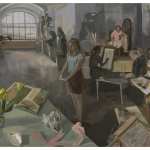
Contributed by Sharon Butler and Jonathan Stevenson / Leslie Wayne, in transcendently clever new work on view at Jack Shainman Gallery through October 21, has encapsulated a significant strand of art history. Renaissance artist Leon Battista Alberti is often credited with the observation that a painting is a window through which to see the world. That was in the 1400s. In 1920, Marcel Duchamp drew up plans for a scaled-down French window, had it constructed by a carpenter he knew out of wood, glass, and paint, and outfitted it with panes made of black leather. He insisted that the leather be polished every day to prevent any kind of illusion from arising in the work. Duchamp’s dark, depthless window was a snarky riff on Alberti’s supposed comment: a painting may be a window, but a window need not illuminate anything much at all. As obtuse and sardonic as Duchamp may have been, he had still done painting the enduring service of bringing the picture more immediately into the physical space of the viewer.

With this phenomenon in mind, in his lecture series at Harvard in the 1980s, Frank Stella came up with the notion of “working space” – that is, activating the space in front of the canvas by building out from the surface. In her show, “Free Experience,” Wayne has boldly embraced the tension between window and working space, and gone Duchamp one better by conjuring windows out of paint itself. She rolls the paint into pieces that are then fashioned into three-dimensional, often ornately substantive, sills, sashes, and panes. The paint becomes not merely tactile and expressive but also structural; her work is, so to speak, beyond painterly. So Wayne is having it three ways — as a creator of paintings, pictures, and sculptures, and perforce of work that is at once illusion and object — while still remaining within the formal and technical constraints of painting. This observation hints at the rich, multivalent rewards of apprehending a Wayne painting.

Two of the most evocative pieces (of many) on display are homonymically entitled Wood and Would, and situated on opposite walls. In the first, mainly green and brown paint spills out over the top and sides of a gently shaped canvas, depicting manmade wood components of a house in various states of decay and imparting the idea of functional rot that might serve to date the contents of an old attic. In the second, the canvas mimics freshly laid wooden flooring, with painted grain, gnarls, and slats. A small, layered blob of white oil paint emerges from one of the slats, intimating potential change — future dereliction, perhaps not unlike that in Wood, or some other transformation — initially implied by the subjunctive cast of the painting’s title.

A viewer could, but need not, link Wood and Would as time-lapsed versions of the same phenomenon. The ambiguity of the pun is a Wayne hallmark. Each of her paintings has forceful independent visual impact, stimulating contemplation without requiring it for some appreciation. The Availability Bias presents in a controlled visual splash the folly of objectivity. Possibly picking up this theme is Indecision, which presents greater visual choice conveyed by variations in color, but emphatically no greater intellectual satisfaction. And thus experiencing that work segues nicely to the irony of the show’s signature painting, Free Experience, an encompassingly snide riff on one’s being in the dark armed only with imperfect preconceptions to light the way. Wayne’s native rigor seems to produce a loosely guiding pattern: her titles are droll prompts that, coupled with a delicate sufficiency of representation, send the viewer’s mind in constructive directions. The surface meanings of Snowmageddon, Swimmer’s Boudoir, Blue Lagoon, and To Be Frank are fairly straightforward — clearly in the field of the window, as it were. But more suggestive secondary meanings — say, respectively, the prospect of yielding to nature’s predation, the quick fade of the pastoral, the unsustainability of pure romance, and the opacity and confusion of what is claimed as simple — emerge to ramify the visual hooks and enrich first impressions.
A Leslie Wayne painting, though a well-defined and resolute object in itself, also launches visual details that prompt existential narratives extending well beyond what is immediately visible. Arguably, accomplishing that free-range duality is what painting — and art- is all about. It’s a special bonus that her work does it with such good cheer.
“Leslie Wayne: Free Experience,” Jack Shainman Gallery, Chelsea, New Yor, NY. Through October 21st, 2017.
Related posts:
Leslie Wayne: Absorbed and wiped out
Weekend report: Studio pop-in with Leslie Wayne and Don Porcaro, Doppler, Crystal Fairy
Textility: Idiosyncratic materiality at the Visual Art Center of New Jersey














Interesting that here is another body of art that has come out of Stella.I just made the case that Zombie Formalism comes out of early Stella. Stella’s post “working space” painting is the inspiration in Wayne’s work. The point in my essay is that Stella’s scission of painting from the optical and spiritual origins of 20thc abstraction and its grounding in ersatz color and geometry makes it impossible for painting to go deeper into the human psyche.Not just outward as in Wayne but inward. http://martinmugar.blogspot.com/2017/10/the-show-goes-on-schnabel-fils-walter.html